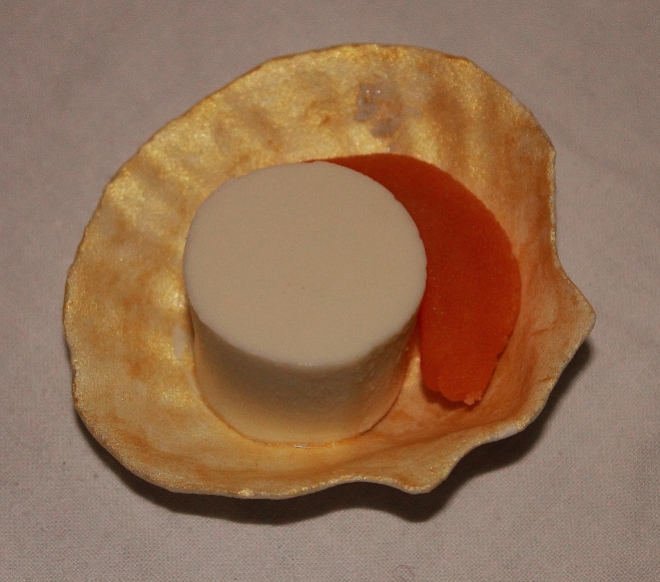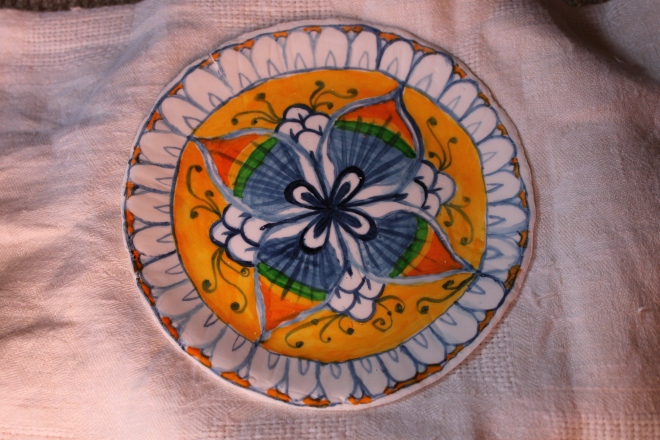Update: For more about The Good Food Feast and even some photos of yours truly in a green and orange gown see the write up in Good Food.
I have a couple of exciting things to share with you, or at least I hope you find them exciting like I do. The first is a recap of the fabulous Good Food Feast which was held in Politarchopolis (Canberra) this weekend by the Politarchopolan Assault Catering Corps. At $125 it was a bit pricier than your average SCA feast, but the Good Food Feast has been much anticipated in the 20 years since the last one, and with four courses, plenty of entertainment and souvenirs of the night we definitely got our moneys worth.
The menu was as follows:
Course the first
Stuffed eggs
Smoked pressed beef tongue
Pickled vegetables
Freshly baked pretzels
Course the second
Baked salmon, served on rye crackers
Oysters with lemon
Golden scallops
Roast goose with green garlic sauce
Course the third
Quail and pigeon pies
Veal with berry sauce
White sausage and pickled cabbage
Pea fritters with garlic sauce
Dessert
Plum tarts
A warm Malavosia Pear tart
Spanish pastry pillows
A selection of fine hand-formed Politarchopolan cheeses, with crisp Gouda biscuits.
Beverages
Homemade cordials
Red or white wine
Red or white hypocras
Homebrewed beer
The highlights were the scallops – a perfectly sculpted sugarpaste shell containing an almond milk and rosewater leach, and an orange marzipan – and the warm pear tart which was my favourite dish of the evening. Special mention also goes to the homemade cheeses, the small bird pies, and the soft, salty pretzels which were served on sticks just as depicted in period paintings.

Scallop Subtletie – an edible sugarpaste shell with an almondmilk and rosewater leach and orange marzipan.
As good as the food was, the real triumph of the evening was in creating the experience of a feast. The team had thought of everything, from wall hangings to scented water to wash our hands with. This attention to detail carried over to the place settings which became our keepsakes for the evening, along with a unique, hand-painted, sugarpaste plate.
Unfortunately, I don’t have many photos of the actual event, but I will try to link some when I can. In the meantime, a couple of weeks ago I managed to acquire some more medlars from a friend who has a tree in the Blue Mountains.
The Recipe
Since my last encounter, I have been looking forward to trying a medlar tart. With my medlars well bletted, I set to work using the recipe ‘To make a tarte of Medlers’ from Thomas Dawson’s ‘The Good Housewife’s Handmaide for the Kitchin’, published in 1594.
To make a tarte of Medlers.
Take medlers that be rotten, and strain them then set them on a chafing dish of coals, and beat it in two yolks of eggs, and let it boil till it be somewhat thicken season it with cinnamon, ginger, and sugar, and lay it in paste.[1]
As you can read about over at the Pilgrim Seasonings blog, this recipe is the earliest of a number of nearly identical recipes published in 16th and 17th century cookbooks.
The Redaction
This is a really easy tart to make, if a bit time consuming, and once again you can always make it even faster by buying shortcrust pastry although there’s something very satisfying about making your own. Feel free to use your favourite pastry recipe if you would rather, or to find a hot water crust recipe as that seems to be the type used in the original cookbook. I used a 24cm pan and didn’t pre-bake the shell, but I would if I was doing it again and have included instructions to do that.
To Make a Medlar Tart
For the pastry:
335g flour
100g butter, chilled and cut into 1cm cubes
1/2 + 1/8 cup of water
1 egg yolk
For the filling:
1 kg medlars
2 egg yolks, beaten
3 spoons sugar
1 1/4 tsp cinnamon
1/2 tsp ginger
- Heat the oven to 180C. Mound the flour in a bowl and rub in the butter until it resembles breadcrumbs. Add the egg yolk and enough water to make a smooth, pliable dough. Roll out the dough and line your pie tin with it. Prick the base with a fork, line the crust with baking paper and fill it with pie beads, dry rice or uncooked lentils and bake it for 15-20 mins.
- Remove the flesh from the medlars by squeezing the pointy end and pushing out the flesh. Push the flesh through a sieve to get rid of the seeds and any fibrous bits.
- Place the sieved medlars into a saucepan over medium heat and stir in the egg yolks. Bring to the boil and cook for 5-10 minutes or until it thickens somewhat. Stir in the sugar and spices and cook for another 5 minutes.
- Pour the filling into the pre-baked pie shell and smooth the top. Bake for 40 mins or until the filling has solidified.
The Round-Up
The Recipe: Medler Tart from ‘The good Huswifes Handmaide for the Kitchin’ (available here)
The Date:1594
How did you make it?: See above.
Time to complete?: About 1.5 hrs.
How successful was it?: It tasted and looked quite a lot like pumpkin pie. It wasn’t overly sweet and was pleasantly spiced.
How accurate?: I used a shortcrust pastry rather than a hot water crust which is the type of pastry referred to in the book, and the lack of quantities makes it hard to know how close I really got to the original.
Bibliography
[1] Thomas Dawson, The Good Huswifes Handmaide for the Kitchin (Imprinted at London by Richard Jones, 1594), http://www.staff.uni-giessen.de/gloning/ghhk/.




egroucutt says:
What could you use instead of medlars? I’ve never seen this fruit in Australia.
July 21, 2015 — 4:15 am
Kim Connor says:
I don’t really know if you can substitute another fruit, since what makes the recipe unusual is the fruit itself. Like I said I got mine from a friend in the Blue Mountains, and you might be able to find them at farmers markets or the odd tree in an old orchard but I don’t think they are grown commercially in Australia.
July 21, 2015 — 4:18 am
egroucutt says:
I shall have to look around. Looks great 🙂
July 21, 2015 — 4:26 am
Daniel Etherington says:
Do you have loquats (Eriobotrya japonica) in Australia? They might be a viable alternative to medlars (Mespilus germanica). Italians call both nespoli as they’re related.
Tracked down a few medlar trees where I’m living in the south of England now so might try this. Got a few months before we see any bletting though. Love that word. Used to leave by a road in London called Medlar St and was always disappointed there were no trees there.
July 21, 2015 — 1:36 pm